Fermanagh v Antrim Statistical Analysis
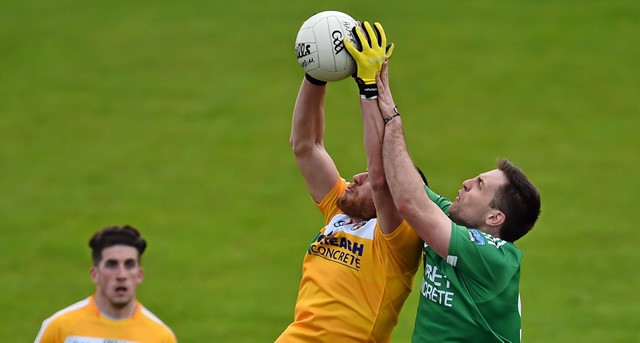
Throughout the 2015 Ulster Senior Championship, Ulster GAA will be compiling a report of the key statistics from each match. The reports will look at a range of factors contributing to game play, including possession breakdown, kick out success, possession to scores ratios and turnover stats.
The purpose of this project is to identify the key differences between team performance, and possibly help pin point where the key differences existed. Ultimately, it is hoped to identify the key area each team needs to address ahead of their next championship outing in 2015.
Kick Out Statistics
For the first time in the Ulster Championship 2015 the winning team on the scoreboard also won the battle for possession from kick outs. Fermanagh claimed 53% of kick outs taken (20/38). However, there is a deeper story to this statistic. Antrim won 57% of first half kick outs (12/21), but only 35% of second half kick outs. This is the first indication of the impact the Antrim sending off had on the intricacies of the match.
Upon further analysis the impact on the kick out contest became very clear. In the first half Antrim won 50% of the Fermanagh kick outs (4/8) while in the second half, following the sending off, Fermanagh won 100% of their 6 kick outs. It appears the sending off left Antrim unable to challenge Fermanagh kick outs. Despite the shift in momentum caused by the sending off, Fermanagh only won 2 more kick outs than Antrim over the course of the match.
Figure 1: Kick Outs Won
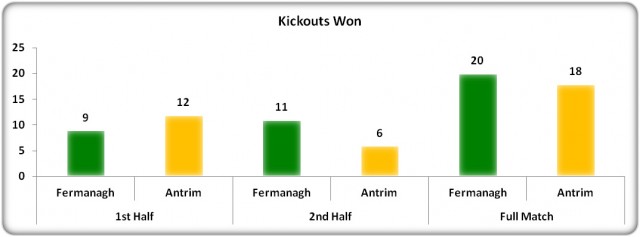
Figure 2: Kick Out Breakdown
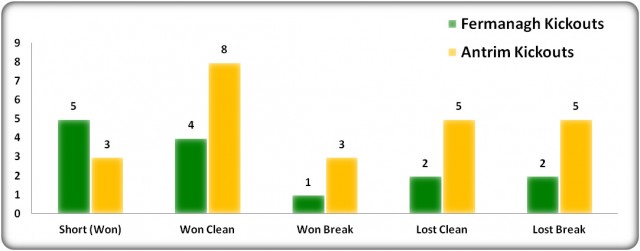
Turnovers
Fermanagh also emerged on the favourable side of the turnover contest, losing possession 23 times, compared to Antrim’s 27 times. Unfortunately for Antrim, having dominated kick out possession in the first half they also gave up possession 16 times, compared to only 11 times in the second half. From an Antrim perspective they will need to focus on the 12 turnovers coming though wayward kick passing, but they also cannot ignore the 5 shots that came up short or were blocked. Fermanagh will look at all their turnovers, and while no single means of turning it over appears overly costly, a total count of 23 will see them struggle in subsequent games.
Figure 3: Turnovers

Possession to Scores Ratios
Fermanagh’s marginal advantage in kick outs and turnovers, coupled with winning the throw in at the start of each half, translated to an overall possession share of 54% (49/90). Add to this that Fermanagh converted 29% of possessions to scores, while Antrim only managed to convert 20%. In the first half Antrim only converted 16% of possessions to scores, while in the second half this rose to 25%. As with their turnover count, they improved in the second half, but due to their numerical disadvantage they struggled to convert these improvements to scoring impact due to the limited possession. In fact, having had 25 possessions in the first half Antrim delivered 4 scores. Despite only 16 possessions in the second half, they also achieved 4 scores.
Neither team broke the 50% success rate with their shooting. Fermanagh scored with 47% of shots, while Antrim managed a 40% success rate. Fermanagh will surely have to pay attention to the 11 efforts that went wide, while Antrim will be concerned by the 5 shots that dropped short, or were blocked down. It is fair to say both will want to see improvement ahead of their next outing. However, both can take encouragement from their 57% success rate in the second half, a big improvement on success rate in the first half (Antrim – 31%, Fermanagh – 38%).
Figure 4A & 4B: Possession to Scores Ratios & Shot Outcomes
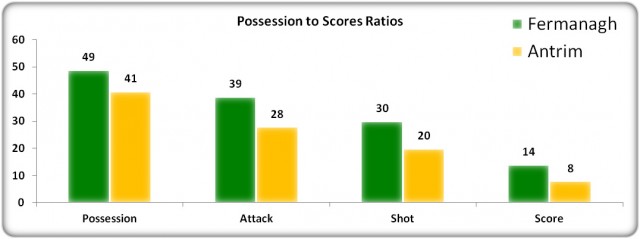
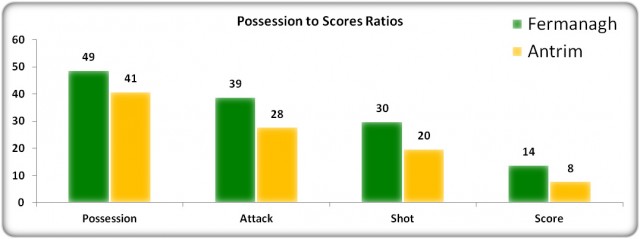
Fermanagh were more productive with their possession, delivering 3.3 points per 10 possessions, while Antrim only managed 2 points per 10 possessions. Fermanagh were much more efficient, and more likely to score with each possession than Antrim. Based on these ratings Antrim would have needed 56 of the 90 possessions (62%) in order to draw the game. They only managed 41 of the 90 possessions (46%).
Figure 5: Productivity
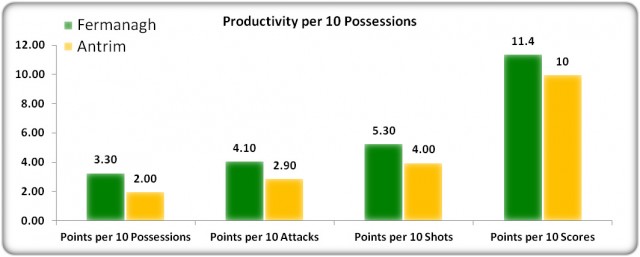
Summary
This game was won by a Fermanagh performance, which was statistically average. There were little or no standout statistics from the winning team; a solid performance, without setting the world alight. The key differences were delivered by Antrim. In the first half Antrim competed on an even basis, gaining an almost 50% share of possession, but were unable to convert this to scores, scoring from only 16% of possessions (31% shot success rate). They also turned over possession on 16 occasions. In the second half, having improved on these areas they were unable to secure enough possession to do any damage on the scoreboard. They increased scoring to 25% of all possessions (57% shot success rate) and limited turnovers to just 11. The issue was that they only secured 16 possessions in the second half, mainly, one suspects due to their numerical disadvantage.
Fermanagh
Fermanagh will be delighted to have got the victory in this game, and will now be keen to set about improving ahead of their semi final with Monaghan. There are a number of areas that they will need to address.
Firstly, they will need to pay attention to kick out share in the first half. When both teams had the full complement of players, they won 43% of the kicks taken. Their own kick outs will need addressed, having won 100% of their own kicks in the second half, but only 50% in the first half when Antrim had all 15 players.
While there are no other major areas of concern, Fermanagh will need to reduce turnover count from 23, and increase shot success rate from 47%. Reducing the wide count of 11 is a reasonable means of improving shot success rate. Some work on shot selection, execution and in particular conversion of free kicks should help reduce wide count and subsequently increase shot success rate.
Antrim
Ahead of their first round qualifier Antrim will be aiming to combine the good from their first and second half performances into an all round performance, with a full complement of players. Their ability to win possession in the first half was unravelled by a high turnover count and poor shot conversion.
However, having improved both in the second half they were unable to gain sufficient possession to impact the scoreboard. It would appear Antrim’s second half problems with gaining possession were mainly due to being reduced to 14 men, and subsequent inability to challenge Fermanagh kick outs. A must for Antrim going forward will be discipline, and ensuring they maintain 15 players. Had they retained 15 players for the second half it would have been interesting to see how their increased efficiency would have fared with greater possession share?






